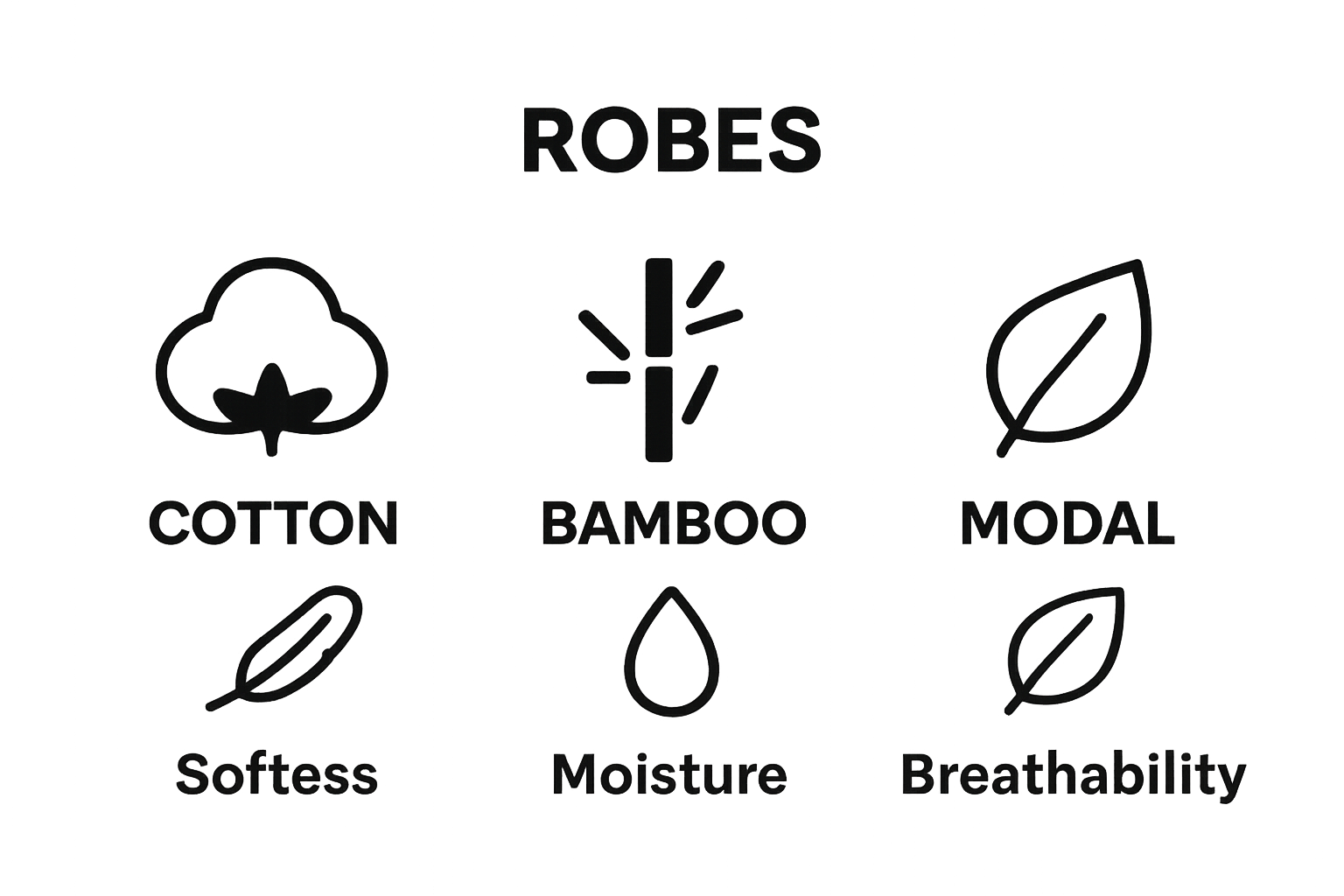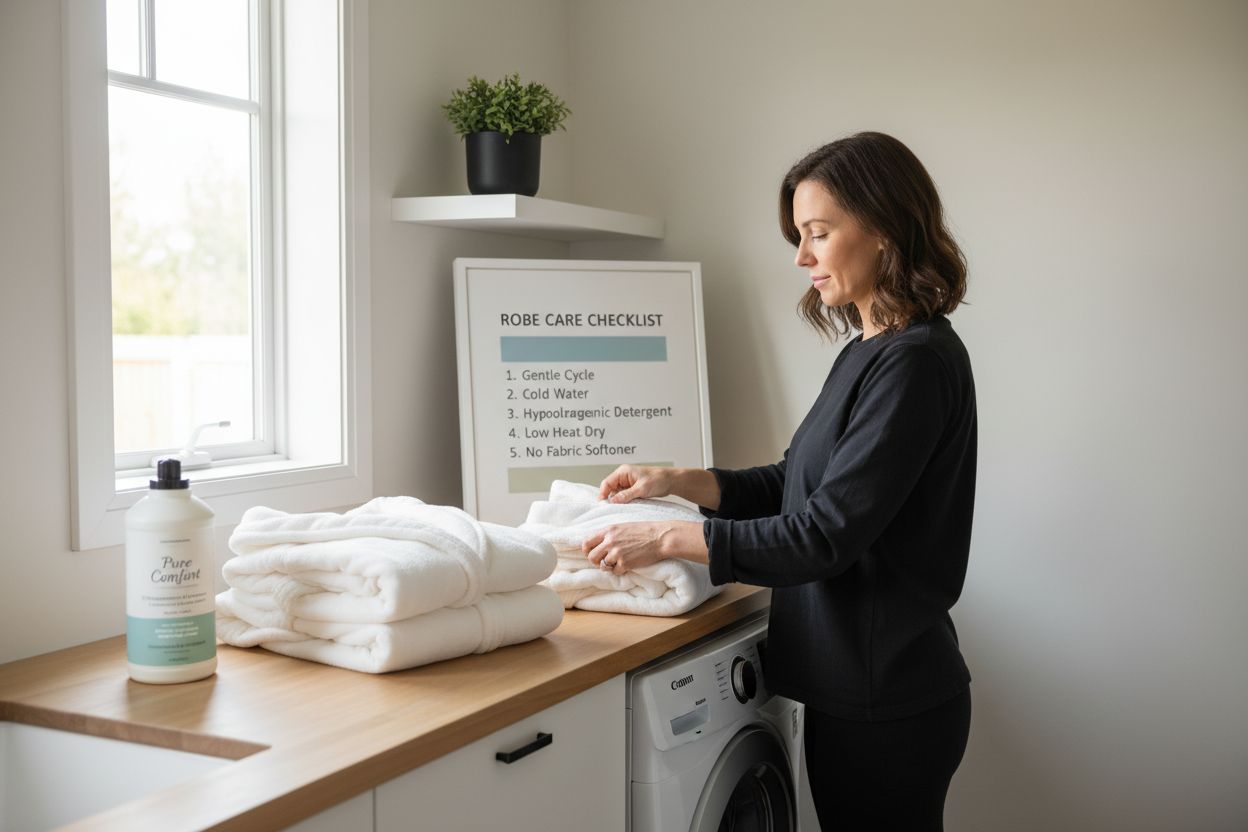People with sensitive skin know the struggle of finding clothes that do not itch or cause breakouts. It sounds obvious to just choose something soft, yet so many robes end up triggering irritation anyway. Research shows that hypoallergenic fabrics can cut down allergic reactions and discomfort by a significant margin, according to the American Academy of Dermatology. Most shoppers look at price tags or color swatches first, but the science of what really makes a robe gentle on your skin is a lot more surprising than you might expect.
Table of Contents
- What Makes Robes Suitable For Sensitive Skin?
- Why Choosing The Right Fabric Matters For Comfort
- The Role Of Design In Minimizing Skin Irritation
- How Proper Care Extends The Life Of Sensitive Skin Robes
Quick Summary
| Takeaway | Explanation |
|---|---|
| Choose natural fibers carefully | Opt for fabrics like organic cotton or bamboo to minimize irritation for sensitive skin. |
| Prioritize moisture management | Select robes that wick moisture to avoid prolonged skin contact with dampness, which can irritate sensitivity. |
| Focus on seamless designs | Look for robes with minimal seams and friction points to enhance comfort and reduce skin irritation risk. |
| Handle with care during laundering | Use hypoallergenic detergents and gentle washing techniques to preserve fabric integrity and skin compatibility. |
| Consider fabric thermal properties | Select breathable materials that offer thermal regulation to maintain comfort and prevent overheating. |
What Makes Robes Suitable for Sensitive Skin?
Routes for individuals with sensitive skin go far beyond simple clothing. They represent a critical intersection of comfort, material science, and personal wellness. Understanding what transforms an ordinary robe into a sanctuary for sensitive skin requires exploring several key characteristics that protect and nurture delicate dermatological needs.
Below is a comparison table highlighting the characteristics of common robe fabrics and their suitability for sensitive skin, based on information provided in the article.
| Fabric Type | Breathability | Irritation Potential | Hypoallergenic | Moisture Management |
|---|---|---|---|---|
| Organic Cotton | High | Low | Yes | Good |
| Bamboo | High | Low | Yes | Good |
| Modal | High | Low | Yes | Good |
| Synthetic Fibers | Low | High | No | Poor |
| Treated Cotton | Moderate | Moderate | Sometimes | Moderate |
Fabric Selection and Skin Compatibility
The foundation of an ideal robe for sensitive skin starts with thoughtful fabric selection. Natural fibers like organic cotton, bamboo, and modal offer superior breathability and minimal irritation potential. Dermatological research from the American Academy of Dermatology confirms that hypoallergenic materials reduce the likelihood of allergic reactions and skin inflammation.
Key considerations for sensitive skin fabric include:

- Smooth, tight weaves that minimize potential skin friction
- Absence of harsh chemical treatments
- Lightweight materials that allow skin to breathe
- Soft textures that reduce potential mechanical irritation
Sensory Characteristics of Skin-Friendly Robes
Beyond material composition, robes for sensitive skin must address sensory interactions. Texture plays a profound role in skin comfort. Soft, lightweight fabrics with minimal surface irregularities prevent potential skin triggers. Smooth seams, tagless designs, and elastic-free configurations help minimize potential friction points that could cause discomfort.
Moisture management is another critical factor. Robes that quickly wick away perspiration and dry rapidly prevent prolonged skin contact with damp fabric, which can exacerbate sensitivity issues. Clinical studies from the Journal of Dermatological Science highlight how moisture-wicking properties can significantly reduce skin irritation risk.
If you’re interested in exploring personalized robe options that cater to sensitive skin, check out our guide on personalized robe ideas for more detailed insights into comfortable loungewear design.
Why Choosing the Right Fabric Matters for Comfort
Fabric selection represents far more than a simple aesthetic choice. For individuals with sensitive skin, clothing material becomes a critical health and wellness decision that directly impacts physical comfort, dermatological well-being, and overall sensory experience.
The Science of Skin Interaction
Fabric performance transcends visual appeal. Research from the Textile Research Institute demonstrates how different materials interact microscopically with human skin, creating complex thermal, mechanical, and biochemical responses. Fabric composition determines critical parameters like moisture absorption, heat retention, friction potential, and potential allergenic reactions.
Key fabric interaction factors include:
- Fiber surface smoothness
- Thermal conductivity
- Moisture-wicking capabilities
- Mechanical flexibility
- Chemical reactivity with skin proteins
Thermal Regulation and Comfort
Optimal fabric selection goes beyond surface texture.
Advanced materials engineer precise thermal equilibrium, managing body heat and moisture with scientific precision. Natural fibers like organic cotton and bamboo excel at creating micro environments that maintain consistent skin temperature, preventing overheating or excessive cooling.
Breathability becomes a critical design parameter. Fabrics with intelligent molecular structures allow air circulation while maintaining insulative properties. This dynamic interaction prevents moisture accumulation, reduces bacterial growth potential, and minimizes skin irritation risks.
If you want to explore more about selecting the perfect robe materials, check out our comprehensive guide to robe materials and comfort, which breaks down the intricate science behind fabric selection.
The Role of Design in Minimizing Skin Irritation
Robe design extends far beyond aesthetic considerations when addressing sensitive skin needs. Strategic architectural choices in garment construction can profoundly mitigate potential skin irritation, transforming a simple piece of clothing into a therapeutic wellness instrument.
Seam and Construction Considerations
Precision engineering in textile design plays a crucial role in skin comfort. Flat-lock seams, minimally intrusive stitching techniques, and reduced friction points become essential strategies for individuals with sensitive dermis. Research from the International Journal of Dermatology highlights how microscopic textile interactions can trigger significant dermatological responses.
Key design elements that minimize skin irritation include:
- Seamless or near-seamless construction
- Reduced internal stitching
- Soft, rolled edges
- Minimal elastic contact points
- Strategic placement of structural elements
Ergonomic Comfort and Movement
Ergonomic design transcends traditional comfort metrics. Robes engineered for sensitive skin must accommodate natural body movements while preventing mechanical stress. Intelligent fabric mapping allows for strategic panel placement, ensuring maximum range of motion without creating friction zones.
Advanced design principles focus on creating garments that move harmoniously with the body, distributing tension evenly and eliminating potential chafing points. Strategically placed gussets, articulated sleeves, and adaptive fit configurations transform robes from static garments into dynamic comfort solutions.
Learn more about our approach to personalized robe design that prioritizes individual comfort and skin sensitivity considerations.
How Proper Care Extends the Life of Sensitive Skin Robes
Maintaining robes for sensitive skin requires a nuanced approach that balances preservation, hygiene, and material integrity. Proper care is not merely about cleaning but about understanding the complex interaction between textile fibers, skin health, and long-term garment performance.
Laundering Techniques for Delicate Fabrics
Washing methodology directly impacts fabric longevity and skin compatibility. Research from the Textile Research Journal reveals that mechanical stress during laundering can compromise fabric structure, potentially increasing skin irritation risks. Gentle cleaning protocols become paramount for preserving both the robe’s physical characteristics and its skin-friendly properties.
Key considerations for sensitive skin robe laundering include:
- Use mild, hypoallergenic detergents
- Select cold or lukewarm water temperatures
- Avoid harsh mechanical agitation
- Minimize fabric softener usage
- Air dry or use low heat settings
Preservation of Fabric Molecular Integrity
Textile science demonstrates that repeated washing can progressively degrade fabric performance. Microscopic fiber alterations occur with each cleaning cycle, potentially reducing the robe’s original skin-protective qualities. Strategic care involves understanding how cleaning processes impact molecular fabric structures.
Advanced preservation techniques focus on maintaining the original textile characteristics. Careful handling, precise temperature control, and minimal chemical interactions help retain the robe’s original thermal regulation and skin-friendly properties. By implementing meticulous care protocols, individuals can significantly extend their robe’s functional lifespan.
The table below summarizes recommended best practices for laundering and caring for robes designed for sensitive skin, providing a quick reference for maintaining material integrity and skin-friendliness.
| Care Step | Best Practice for Sensitive Skin Robes |
|---|---|
| Detergent Choice | Use mild, hypoallergenic detergents |
| Water Temperature | Wash in cold or lukewarm water |
| Agitation Level | Avoid harsh mechanical agitation |
| Fabric Softener | Minimize usage |
| Drying Method | Air dry or use low heat settings |
| Purpose | Preserve fabric integrity and skin compatibility |

Learn more about robust bath linen care techniques that ensure your sensitive skin robes remain in optimal condition.
Experience Soothing Comfort with Robes Made for Sensitive Skin
If you struggle to find loungewear that is gentle on delicate skin, you deserve a solution that combines careful fabric selection, thoughtful design, and pure comfort. The search for robes that keep irritation at bay is over when you explore the Plush Robes for Women and Soft Men Cotton Robes collections at Lotus Linen. Your sensitive skin will appreciate the smooth textures, lightweight materials, and skin-friendly construction described in this article.

Make a positive change for your comfort and confidence today. Browse Lotus Linen to discover robes tailored for sensitive skin and see how easy it is to care for your well-being at home. Upgrade to robes that work with your body and enjoy everyday relief—choose comfort now for a difference you can feel.
Frequently Asked Questions
What fabrics are best for robes designed for sensitive skin?
Natural fibers like organic cotton, bamboo, and modal are ideal for sensitive skin. These materials offer superior breathability, reduced irritation potential, and are often hypoallergenic, minimizing allergic reactions and skin inflammation.
How can I minimize skin irritation when wearing a robe?
Choosing robes with smooth textures, minimal seams, and tagless designs can significantly reduce friction. Additionally, selecting lightweight, moisture-wicking fabrics helps manage perspiration and prevents skin discomfort.
What washing techniques should I use to care for sensitive skin robes?
Use mild, hypoallergenic detergents and wash in cold or lukewarm water. Avoid harsh agitation, minimize fabric softener usage, and air dry or use low heat settings to preserve the robe’s fabric integrity and skin-friendly properties.
How does robe design impact comfort for individuals with sensitive skin?
Robe design features such as seamless construction, soft edges, and ergonomic fit can greatly enhance comfort. These elements help prevent mechanical stress and chafing, making the robe more suitable for those with delicate skin.
